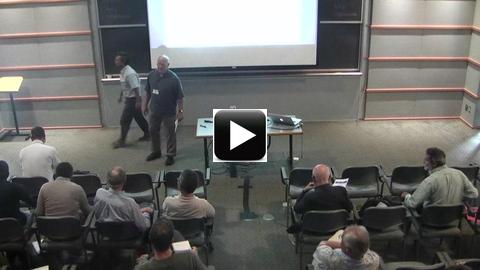Oceanic submesoscale currents near the surface primarily have patterns of lines or streaks with
widths of 10-1000 m. The lines are made visible by high concentrations of buoyant surface
materials (much of which is biogenic scum) that are pushed together where horizontal currents
converge and feed into downward current sheets, leaving the surfactants behind. These lines
are created by the process of frontogenesis where horizontal differences in density are
compacted into smaller cross-front transition zones, with the associated current patterns
following along. Two primary points are made in this talk: (1) the currents that cause the
frontogenesis are created by the combined effects of the density differences, Coriolis force, and
vertical momentum mixing associated with turbulence in the surface boundary layer; (2) the rate
of frontogenesis is equivalent to the rate of frontogenesis once the front is strong enough.
Statement (2) is not the common view of meteorological weather fronts where the frontogenesis
rate is usually attributed to the strain rate of the winds, which can be true for weak and
moderate fronts, but not for strong ones. The details of frontogenesis at the ocean surface are
also influenced by surface gravity waves.

To download: Right-click and choose "Save Link As..." (Other video options)
To begin viewing slides, click on the first slide below. (Or, view as pdf.)
![[01]](tn/01.jpg)
![[02]](tn/02.jpg)
![[03]](tn/03.jpg)
![[04]](tn/04.jpg)
![[05]](tn/05.jpg)
![[06]](tn/06.jpg)
![[07]](tn/07.jpg)
![[08]](tn/08.jpg)
![[09]](tn/09.jpg)
![[10]](tn/10.jpg)
![[11]](tn/11.jpg)
![[12]](tn/12.jpg)
![[13]](tn/13.jpg)
![[14]](tn/14.jpg)
![[15]](tn/15.jpg)
![[16]](tn/16.jpg)
![[17]](tn/17.jpg)
![[18]](tn/18.jpg)
![[19]](tn/19.jpg)
![[20]](tn/20.jpg)
![[21]](tn/21.jpg)
![[22]](tn/22.jpg)
![[23]](tn/23.jpg)
![[24]](tn/24.jpg)
![[25]](tn/25.jpg)
![[26]](tn/26.jpg)
![[27]](tn/27.jpg)
![[28]](tn/28.jpg)
![[29]](tn/29.jpg)
![[30]](tn/30.jpg)